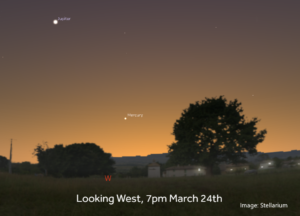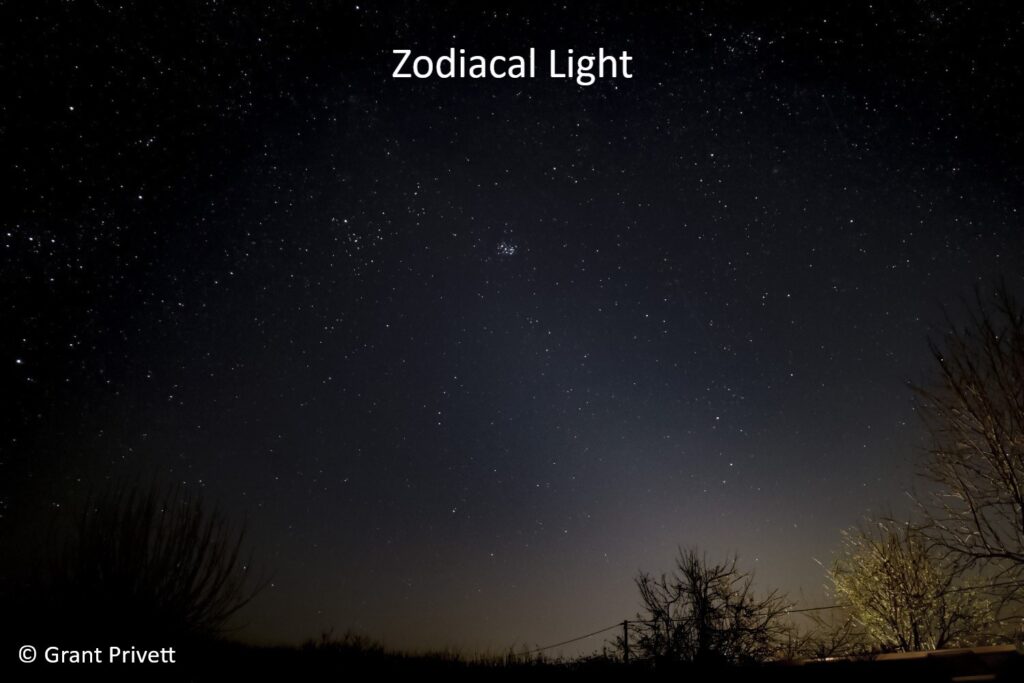March Stargazing
This month, our Dark sky Advisor Steve Tonkin takes a look at three Solar System phenomena.
 The first of these is the Vernal (Spring) Equinox on the 20th March. Equinox means ‘equal night’; they occur twice a year and on those days the night (as measured from sunset to sunrise) is the same length as the day. You’ll have noticed that, as we approach summer, the midday Sun has been gradually getting higher; the equinoxes are when it is directly overhead on the Equator. Of course, we cannot directly experience that from here, but we can experience two associated phenomena:
The first of these is the Vernal (Spring) Equinox on the 20th March. Equinox means ‘equal night’; they occur twice a year and on those days the night (as measured from sunset to sunrise) is the same length as the day. You’ll have noticed that, as we approach summer, the midday Sun has been gradually getting higher; the equinoxes are when it is directly overhead on the Equator. Of course, we cannot directly experience that from here, but we can experience two associated phenomena:
- The direction of sunrise and sunset shadows: at the equinoxes, these are cast due west and due east respectively, because the sunrise and sunset occur due east and due west.
- If you note the changing sunrise and sunset positions on the horizon, the difference from day to day is greatest at the equinoxes. You can compare this to the solstices, where it hardly changes at all from day to day (‘solstice’ means ‘sun stationary’).
Our second phenomenon is an opportunity to see the elusive planet Mercury. Mercury is the closest planet to the Sun and, because of this, it orbits most rapidly, taking only 88 days to orbit our parent star. We see this rapid movement day to day against the background sky and, because it is never far from the Sun, it is only ever visible in twilight. This fleet-footed nature is the reason that the ancients dubbed it the Messenger of the Gods.
 Mercury is so tricky to see that even some quite eminent astronomers of the pre-telescope age (Copernicus, for example) never managed to see it – but you can! To make it easier for yourself, use binoculars if you have them. A week either side of March 24th (the date it will be easiest) look in the western sky after sunset. You should be able to see a star-like object between the bright planet Jupiter and the brightest part of the sunset glow. Once you have it, track it from night to night, and you’ll see how quickly its position changes. (If you are using binoculars, do not scan the sky until the Sun has set!)
Mercury is so tricky to see that even some quite eminent astronomers of the pre-telescope age (Copernicus, for example) never managed to see it – but you can! To make it easier for yourself, use binoculars if you have them. A week either side of March 24th (the date it will be easiest) look in the western sky after sunset. You should be able to see a star-like object between the bright planet Jupiter and the brightest part of the sunset glow. Once you have it, track it from night to night, and you’ll see how quickly its position changes. (If you are using binoculars, do not scan the sky until the Sun has set!)
To see our last phenomenon, you’re going to need a dark, transparent, Moonless sky, a clear western horizon, and properly dark-adapted eyes. Give your eyes at least 20 light-free minutes and look in the west (where Jupiter is). You should be able to see an ethereal narrow wedge of light reaching up towards Jupiter. This is the Zodiacal Light; it is Sunlight reflected off dust in the plane of the Solar System.
The Zodiacal Light is only visible from the darkest locations. If you want see how you can help to preserve the dark environment of Cranborne Chase International Dark Sky Reserve, a good place to start would be an audit of your own exterior lighting using this handy flow-chart. If you need to make any lighting dark-sky friendly, contact Steve Tonkin, who may be able to give you the appropriate lights or motion sensors.
Find out more about the Dark Sky of Cranborne Chase National Landscape.
